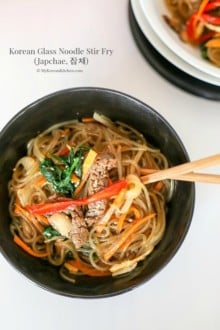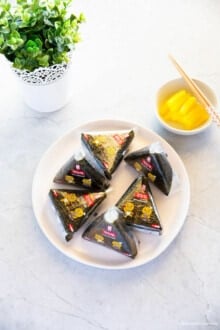Learn about the most used Korean cooking ingredients!
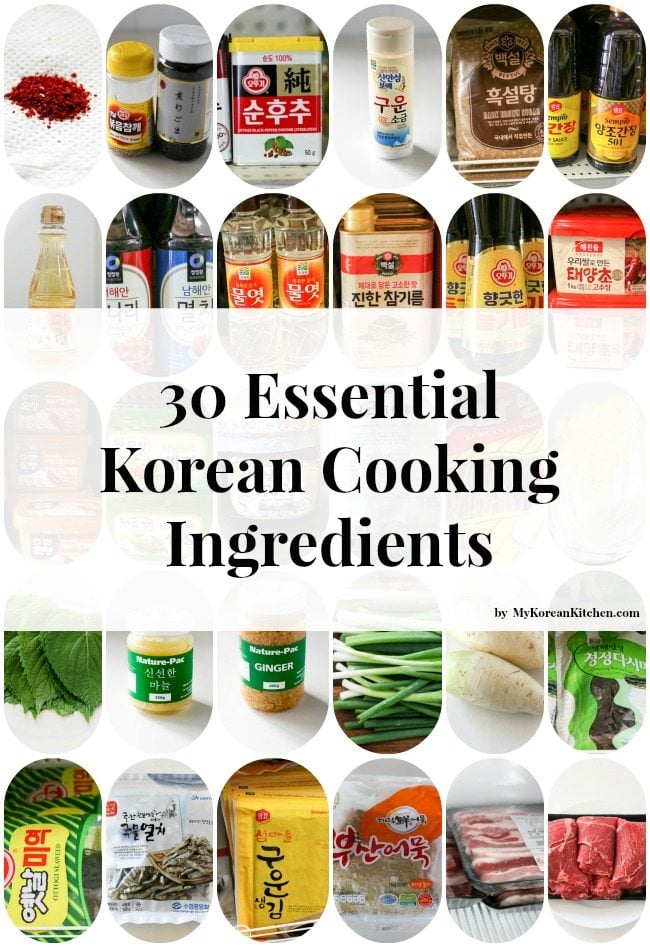
Today I’m sharing 30 essential Korean cooking ingredients.
This type of article isn’t as glamorous as some other recipes I share here, nonetheless, I thought it would be great to share my list to enhance your Korean cooking knowledge and help you update your pantry if necessary. 🙂
Just a friendly warning that this is a long article. If you want to look up a particular ingredient, just press Ctrl +F (or Command +F for mac) and enter the keyword you want to search. With these Korean ingredients, I hope you have a great time trying out my recipes!
Essential Korean Cooking Ingredients
Essential Ingredients – Dried
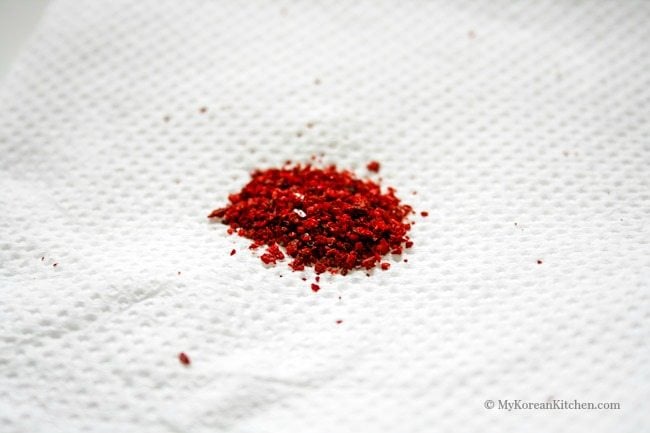
Korean chili powder / Hot pepper flakes (Gochugaru: 고추가루) – Most Korean spiciness comes from this magic powder called gochugaru. It is essentially made with dried Korean red chilies. It mainly comes in two different formats – fine and coarse. Fine chili powder is mostly used when making gochujang and coarse chili powder covers the rest of Korean cooking needs.
So I buy coarse chili powder more frequently and store it in my fridge as it can get mouldy if you don’t store it well (e.g. storing it at room temperature). If your gochugaru starts hardening, you can use the food processor to separate it again. Just a few seconds of pulse will fix it. Read more about it from my other post – Gochugaru.
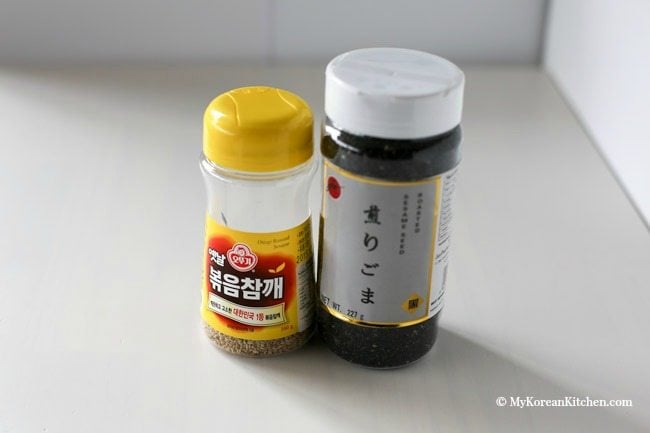
Roasted sesame seeds (Bokken chamggae: 볶은 참깨) – Roasted sesame seeds are usually used in a dish as a garnish. It adds a nutty warm flavor and nice crunchy texture to the dish. Typically it is used in Korean vegetable side dishes (Namul, 나물) and also in dipping sauces. I use both Korean (left) and Japanese (right) brand depending on the sesame seeds color I need at the time.
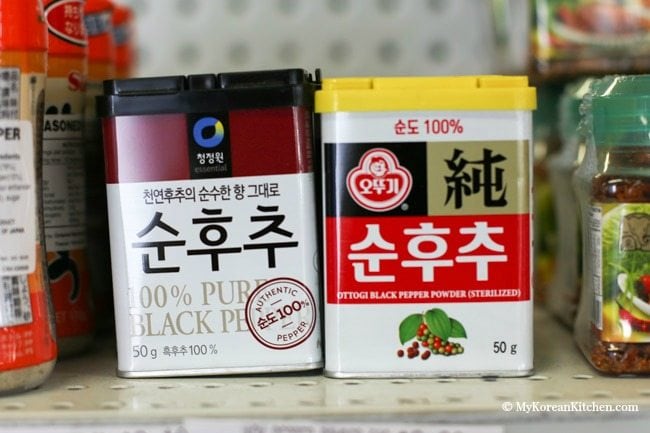
Ground black pepper (Huchu:후추) – Ground black pepper is typically used when marinating BBQ meat. It helps get rid of the unique meat smell. I also love shaking this in to my Korean rice cake soup (Ddeok Guk, 떡국). It adds a nice aroma and mild spice kick to this bland soup. I just buy a bottle of whole black pepper (non-Korean) brand and ground it as I need it. For those of you who want to try Korean brand black pepper, the above picture on the right is one of them. Probably the most popular one.
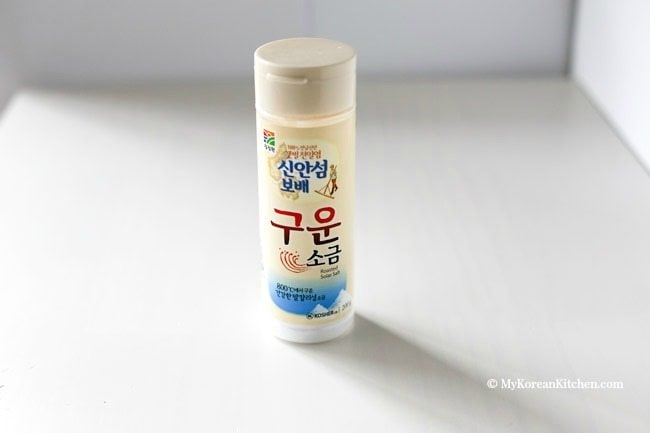
Salt (Sogum: 소금) – Salt is essential in any type of cooking but I thought I would show what I use. For my general cooking needs, I’ve been using the above Guun Sogum (구운소금: Roasted solar salt) for a few years. I really like this salt. I would consider it as a mild salt. The particles are very fine and it’s not too salty or bitter or sour. It’s also Kosher certified.
According to the manufacturer, “Korean Solar Salt is created by evaporation of sea water by wind and the sun. Because it contains so many healthy minerals, it is not too salty or sour so brings out the natural flavor of the dish. This salt is produced at “The Jewel of Shinan Island”, which is classified as an UNESCO Biosphere Reserve area so its natural quality is supposedly better than any others.
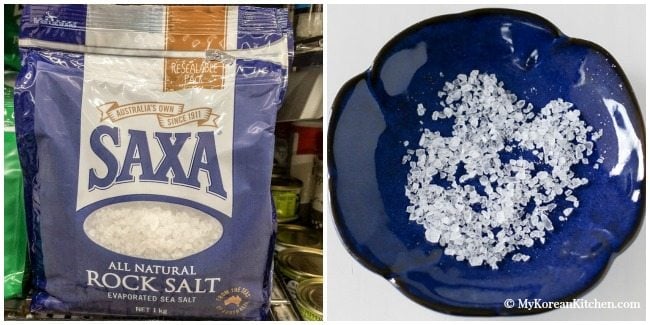
Though, when I make Kimchi or other pickled Korean dishes, I use rock salt (non-Korean brand). I was first introduced to this rock salt by my Brazilian friend. She used it when she makes Brazilian style steaks, which were marvelous. When I had some leftover rock salt after making these steaks, I tried them in some Kimchi and cucumber salad recipes and it worked great.
Basically when you make Kimchi or other pickled dishes, you need to use coarse salt rather than fine salt. I found that this rock salt is slightly larger than the typical Korean salt that are used in Kimchi. However I think this rock salt is more versatile for my general cooking needs and that’s why I’m using it. Check Korean salt for Kimchi (or pickle) if you’re looking for a Korean branded coarse salt (굵은 소금).
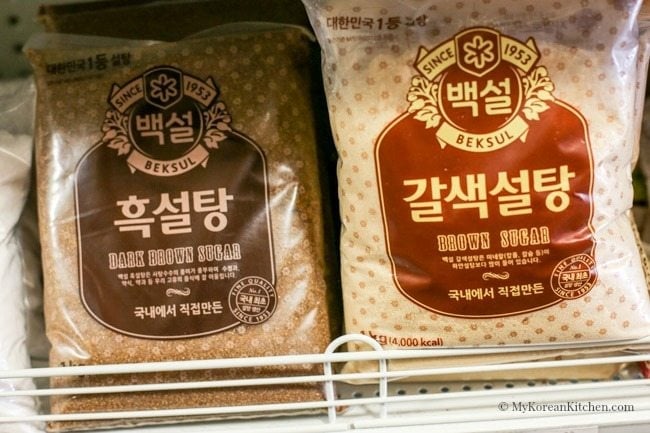
Sugar (Sultang: 설탕) – My husband thinks Koreans use sugar a lot in their main dishs. Do you think so too? I didn’t realise that until he pointed it out a very long time ago. In my defence, Koreans use sauces that are too strong on their own (soy sauce – salty, gochujang – spicy etc), so you need to balance it by adding something sweet (e.g. sugar) in the cooking. Well, that’s my theory anyway.
Typically, there are three different kinds of sugar – white sugar, yellow sugar and dark brown sugar in Korea. Some Koreans prefer using liquid forms of sugar (e.g. rice syrup or corn syrup or oligosaccharides) instead of powder forms of sugar. When I use powder forms of sugar, I use raw sugar 95% of the time as it’s the least processed. I only use white sugar (e.g. in a radish pickle) and dark brown sugar (e.g. in marinating a soy based BBQ meat) when the color of the food is important (e.g. for food photography or party food)
Essential Ingredients – Liquid
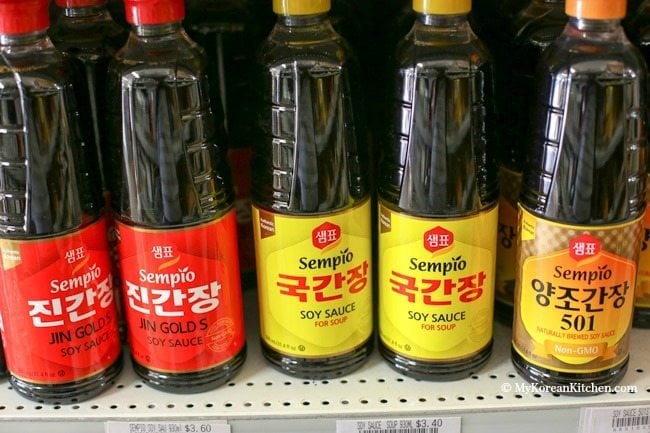
Soy sauce (Ganjang: 간장) – There are a few different kinds of soy sauce available in Korea. Each of those have a different name based on the ingredients used and/or the method of brewing. I will cover that in more detail in a separate post some other time as it can be lengthy.
For my day to day cooking needs (e.g. stir fry, braising etc), I use 100% naturally brewed soy sauce – Kikoman brand. If you’re looking to buy a Korean brand of this kind, Yangjo Ganjang (양조간장) is the name you should be looking for. For soup and stew, I use soy sauce that’s made for soup. It’s saltier than other kinds of soy sauce but the color is lighter. It can be also be used as an alternative to salt and it adds deeper umami.
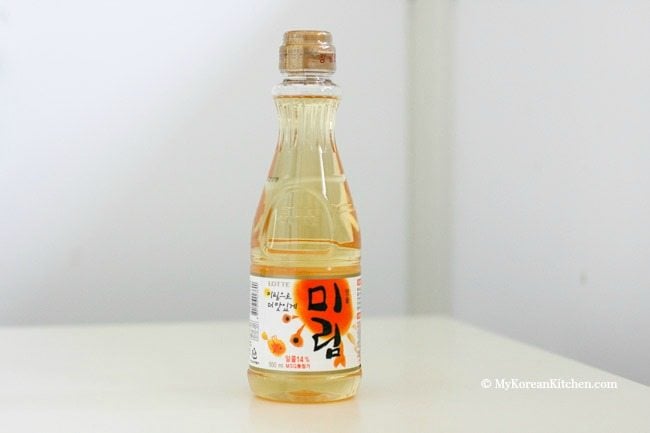
Rice wine/cooking wine (Mirim: 미림) – I use rice wine particularly when marinating meat for a BBQ. It gets rid of the meat smell and it’s also known to add a slightly sweet note to the main dish. Japanese Mirin (미린) does the same job. You can read more about cooking wine from my other post.
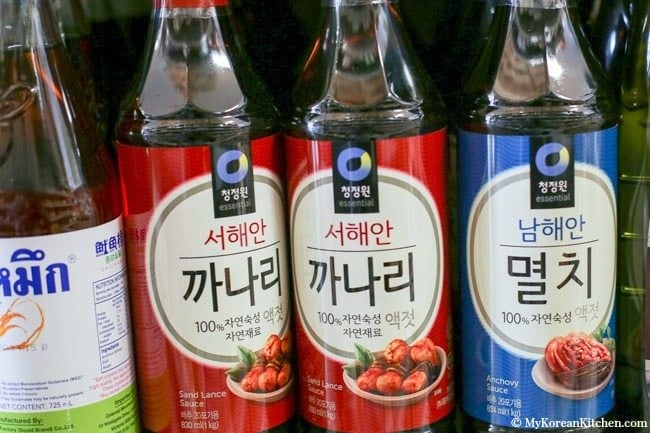
Korean fish sauce (Aecjeot: 액젓) – Korean fish sauce is typically used in varieties of Kimchi to accelerate the fermentation process. In some occasions, it is also used in Korean side dishes and soup/stew. There are two main varieties of Korean fish sauce – anchovy sauce (Mulchi Aecjeot) and sand lance sauce (Kkanari Aecjeot). I’ve only used anchovy sauce so far. Some people also commented on this post that it cannot be substituted with Thai/Vietnamese fish sauce.
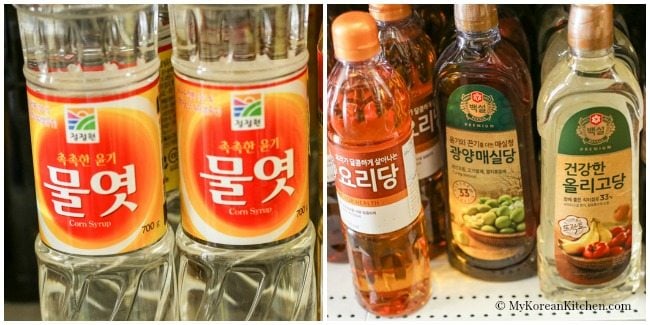
Korean malt syrup/rice syrup/corn syrup (Mulyeot: 물엿) – These are a liquid form of sweetener. Koreans use it a lot to give food a sweet flavor but also to give a shiny look. I used to use it a lot when I was living in Korea, but I don’t use it anymore as I think it’s not a healthy ingredient. If I want to give a sweet flavor and shiny look, I use honey or 100% pure maple syrup depending on the recipe instead.
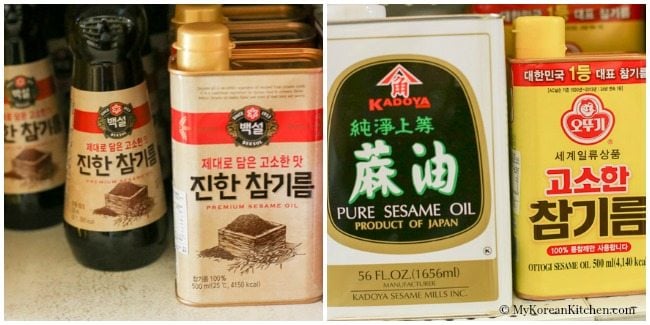
Sesame oil (Chamgireum: 참기름) – Sesame oil is widely used in many Korean side dishes, rice dishes, Korean BBQ and in dipping sauce as a finishing touch ingredient. It adds a nutty aroma and savoury flavor. I typically use Korean brand sesame oil but I know some people swear by Kadoya brand.
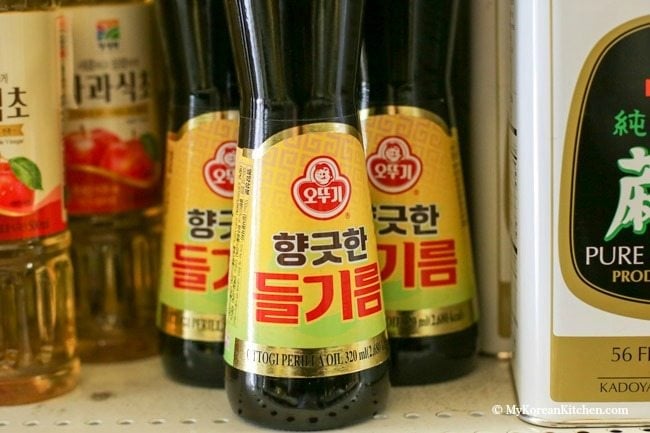
Perilla oil (Deulgireum: 들기름) – Perilla oil is made from perilla seeds (by cold-pressing) and it is also used in some Korean vegetable side dishes. Perilla oil is known for its highly nutritious ingredients but it has a lot shorter shelf life (under 6 months) than sesame oil (6 months to 2 years).
Essential Ingredients – Paste

Korean chili paste/Hot pepper paste (Gochujang: 고추장) – Does it need further explanation? Gochujang is probably the most famous Korean condiment. It goes in side dishes, soup & stew, main dishes, marinade etc. It is made from fine Korean chili powder, glutinous rice, fermented soybeans and salt. While it’s spicy, it also has a very subtle sweet note.
Nowadays, there are various versions of gochujang (ie. extra spicy gochujang, less spicy gochujang and beef seasoned gochujang etc), however my recipes are based on the standard version of gochujang. You can read more about gochujang from my other post.
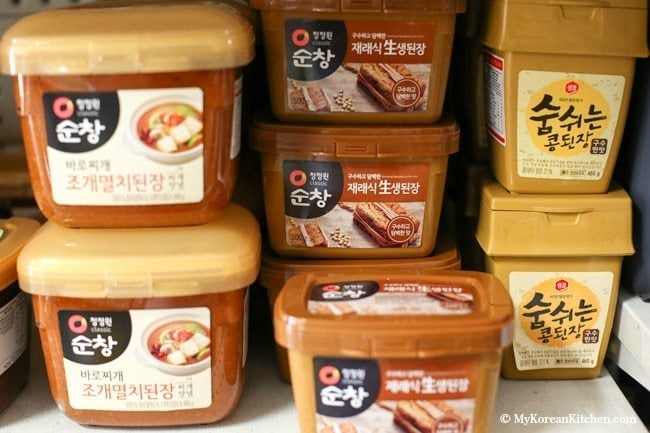
Soybean paste (Doenjang: 된장) – Korean soybean paste is often compared with Japanese miso paste. It is made with fermented soybeans over a period of time. It has natural pungent smell and flavor. It is mainly used in soup & stew but it can also be used as a sauce when making side dishes.
As with gochujang, there are various versions of soybean paste available (e.g. soybean paste mixed with seafood extract) however my recipes are based on the standard version of soybean paste.
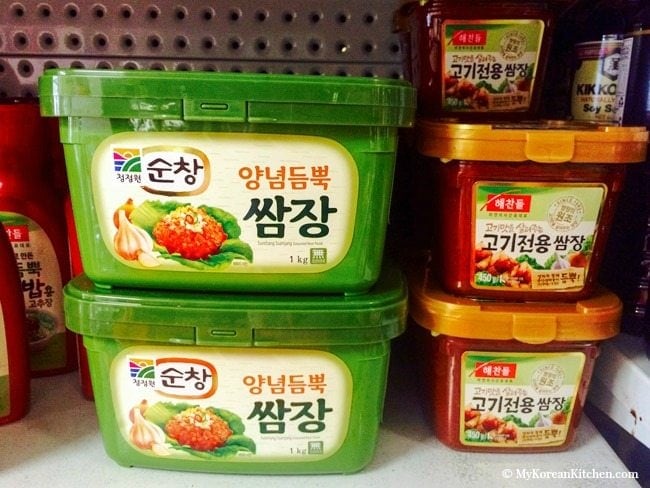
Korean spicy dipping sauce (Ssamjang: 쌈장) – Korean spicy dipping sauce is most commonly accompanied with grilled Korean BBQ. It can be easily made at home using soybean paste, chili paste, garlic, onion, sesame oil etc. Check out my fancier version of this dipping sauce recipe if you want to make it from scratch.
As with chili paste (Gochujang) and soybean paste (Doenjang), there are various versions of spicy dipping sauce available. You can read more about spicy dipping sauce from my other post.
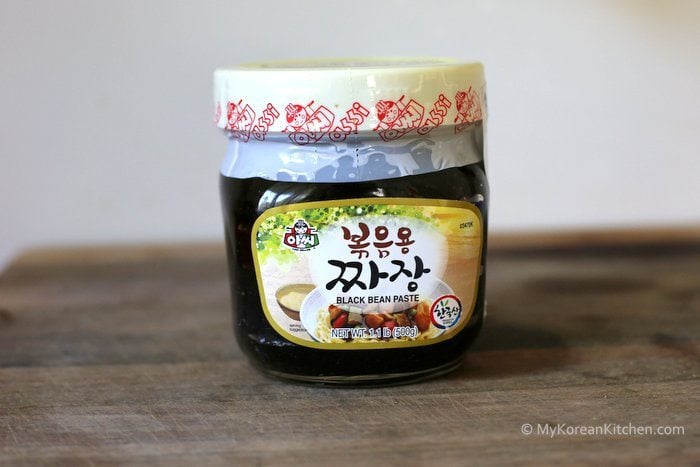
Korean black bean paste sauce (Chunjang: 춘장) – Korean black bean paste sauce is mainly used when making Jajangmyeon or Jajangbap. While there are powder versions available, I prefer using the paste version as it’s tastier and has deeper umami.
In most cases, this black bean paste sauce needs further cooking before it can be used as it has a bitter taste on its own. If you follow my Jajangmyeon recipe, the instruction is included there.
Essential Ingredients – Grains and Noodles
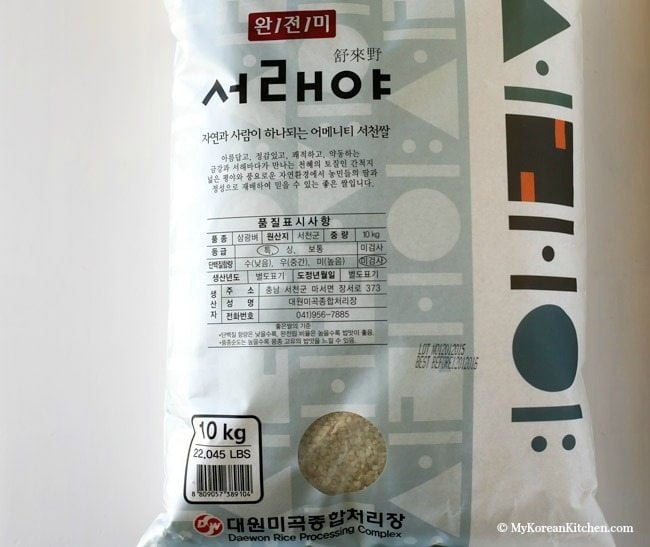
Short grain white rice (Ssal: 쌀) – Short grain white rice is a typical Korean rice species. Once cooked, the rice grains sticks to each other. It has a slightly shiny look and slightly sweet taste. Japanese sushi rice is also short grain rice and this can be used alternatively.
At present, I’m using Australian brand medium grain white rice simply because this is a cheaper alternative to Korean rice or Japanese rice. Though I find this quite inferior to Korean or Japanese rice. You may also want to read my other post, how to cook perfect Korean steamed rice.

Sweet potato noodles /Korean glass noodles (Dangmyeon: 당면) – Sweet potato noodles are clear dried noodles made with sweet potato starch. They are most commonly used in Korean mixed noodles and vegetables (Japchae). The noodles come in large dried bundles and they are hard to separate. However, there is also a pre-cut version that are really easy to use as well. So look out for those if you can.
To cook, you soak them in warm water for several minutes or boil depending on the recipe. They are similar to cellophane noodles but have a firmer and more resilient texture.
Essential Ingredients – Vegetables
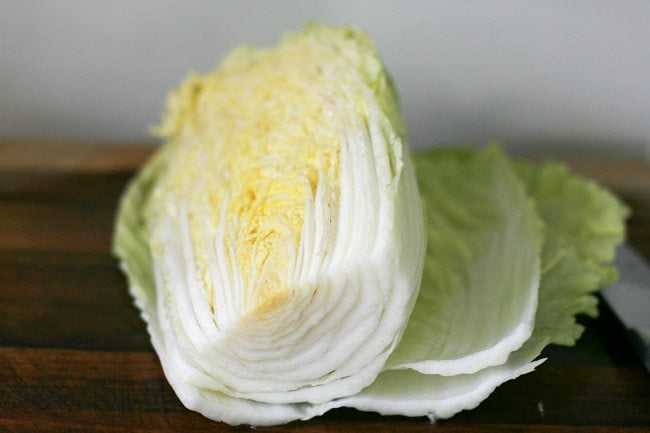
Napa cabbage/ Chinese cabbage/ Wombok (Baechu: 배추) – Napa cabbage is most commonly used when making Kimchi, which means it is a VERY important ingredient. Napa cabbage is also used in a sautéed side dish, in napa cabbage soup (Baechuguk) and it can also be used as a wrap (Ssam, 쌈).
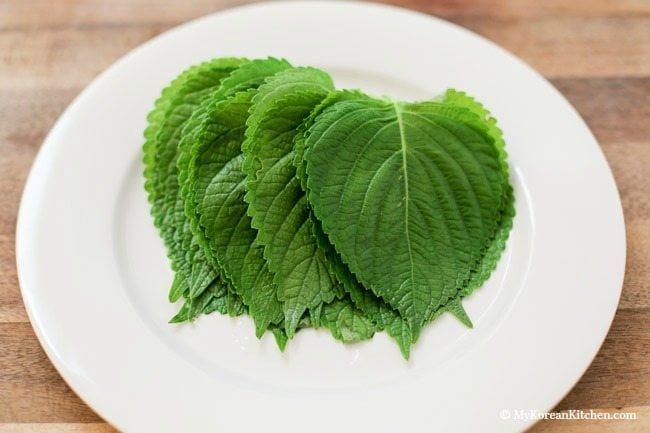
Perilla leaves (Gganip: 깻잎) – Perilla leaves are used in a pickled side dish, in stir fry and as a wrap. They are part of the mint family and have a strong aroma. They are similar to Japanese shiso, but they are known to have a different flavor and shape.
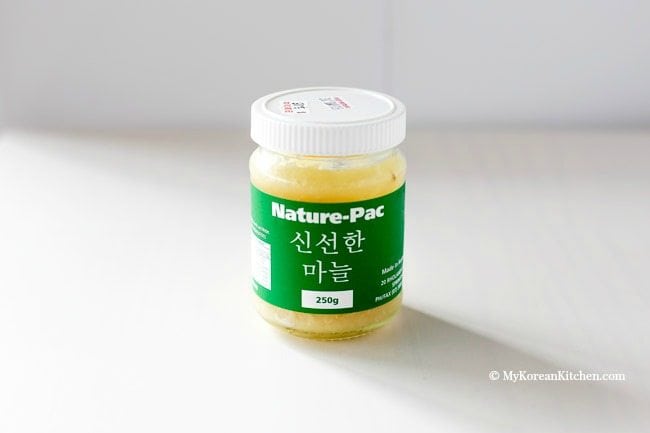
Garlic (Manul: 마늘) – Unless it’s a dessert dish or plain steamed rice, you should expect to add some garlic in practically every Korean dish – soup, stew, side dishes, main dishes. I normally buy a glass bottle of minced garlic (250g) from a Korean grocery store and it usually lasts me about 2 to 3 months.
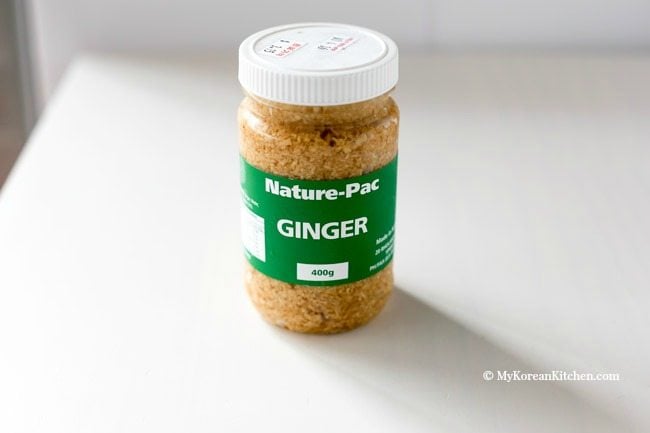
Ginger (Saenggang: 생강) – Ginger is also another vegetable commonly used along side garlic. (Though it’s less frequently used than garlic). Ginger is typically used in marinade sauce, in Kimchi or in some Korean tea.
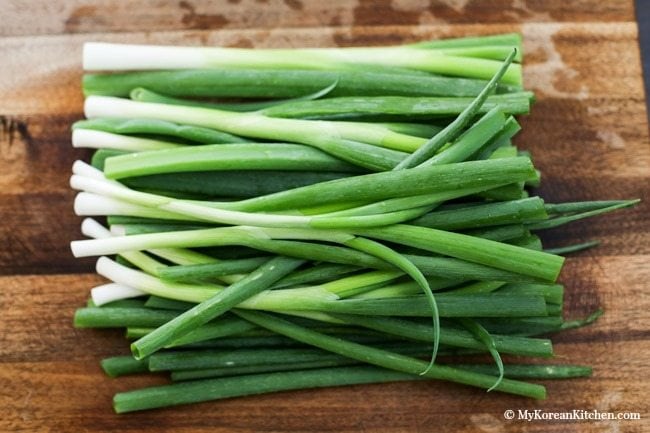
Green onion/scallion/shallots/spring onion (Pa: 파) – Green onion is used as a side vegetable in many type of kimchi, also as a main ingredient in pancakes and salad. It is also used in making broth and also as a garnish on top of food. [Don’t forget to check out my tips on how to store green onions for a long time too. (I mean like 5 to 6 weeks! & No planting is involved!)]
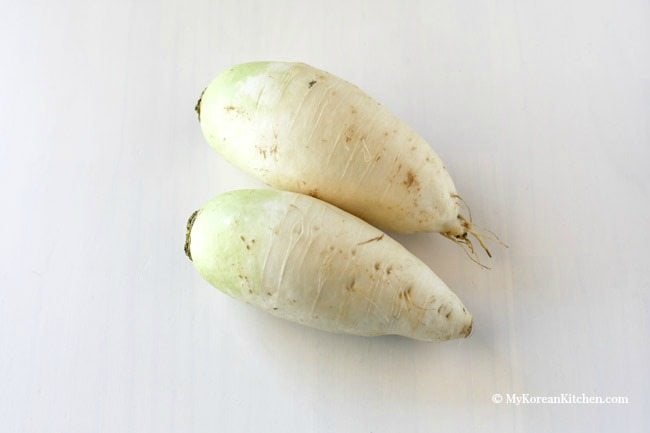
Korean radish/Daikon radish/White radish (Mu :무) – Korean radish is used when making cubed radish Kimchi, white radish pickles or in various soups and stews. While it is a variety of Daikon radish, Korean radish tends to be shorter and rounder than typical Daikon radish. It also has some shades of green. If I can’t get Korean radish, I just use daikon radish instead (even this can be very challenging to find where I live!). If you’re interested, you can read my other post on How to pick a fresh and delicious white radish.
Essential Ingredients – From the sea
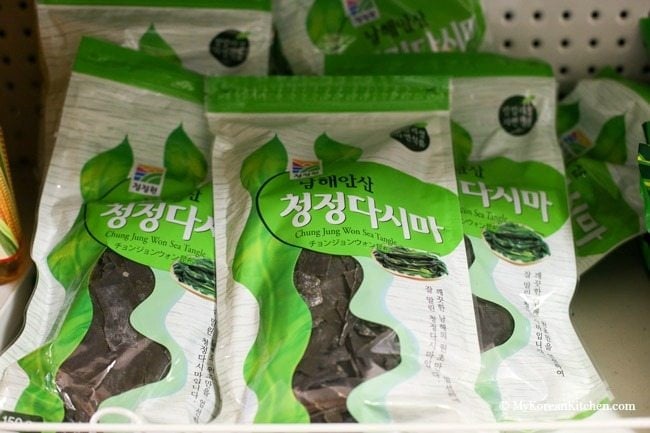
Sea kelp (Dashima: 다시마) – Sea kelp (also known as Kombu) is mainly used when making stock (Korean style dashi). You buy dried sea kelp and soak it in a bowl of water for 1 hour (or more) to use. In this case, you’re mainly using the water that’s been sitting with the sea kelp not the sea kelp itself. You can also use sea kelp when making deep fried sea kelp side dish.
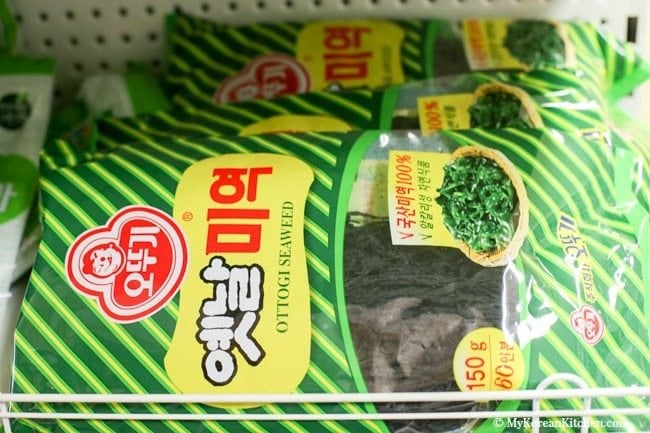
Sea mustard (Miyeok: 미역) – Sea mustard (also known as Wakame) is mainly used in Korean seaweed soup (aka Korean birthday soup). You buy dried seaweed and soak it in a bowl of water for 10-15 mins then it will swell and is ready for use. You can also buy fresh sea mustard (Mul miyeok, 물미역) in Korea and this is often used when making side dishes.
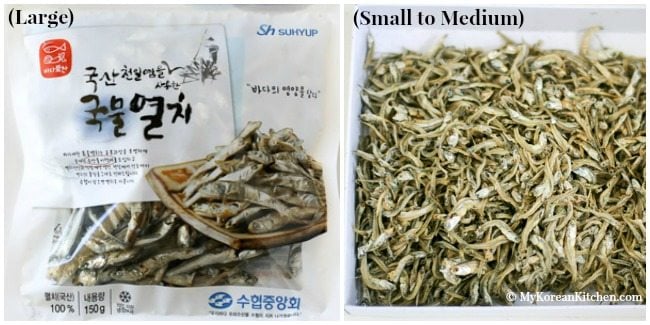
Dried anchovy (Marun Myeolchi: 마른 멸치) – Large dried anchovy is used when making stock (Korean style dashi). Small to medium dried anchovy is used when making braised or stir fried Korean side dishes.
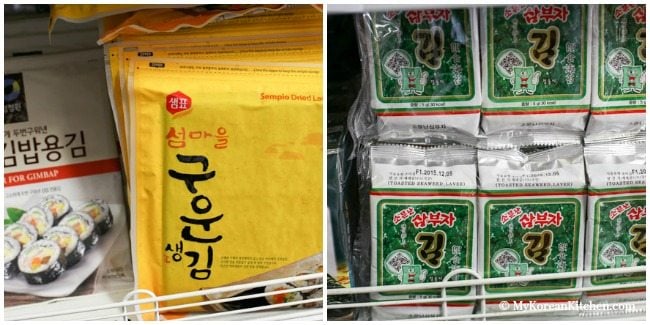
Seaweed (Gim: 김) – Non-seasoned seaweed is most commonly used when making Kimbap (김밥, Korean rice rolls) or as a garnish in rice cake soup. Seasoned seaweed is used as a side dish. Slightly salty and sesame oil brushed seaweed is particularly popular with kids. It can also be used as a garnish on stir fried rice. Some people use it as a drink snack (with beer).

Korean fish cakes (Eomuk: 어묵) – Korean fish cakes are commonly used in stir fry dishes or in soup. They are available in a few different shapes (e.g. square, rectangle, round, bar etc). You can also make it at home from scratch using my recipes. Read more about Korean fish cakes from my other post.
Essential Ingredients – Meat
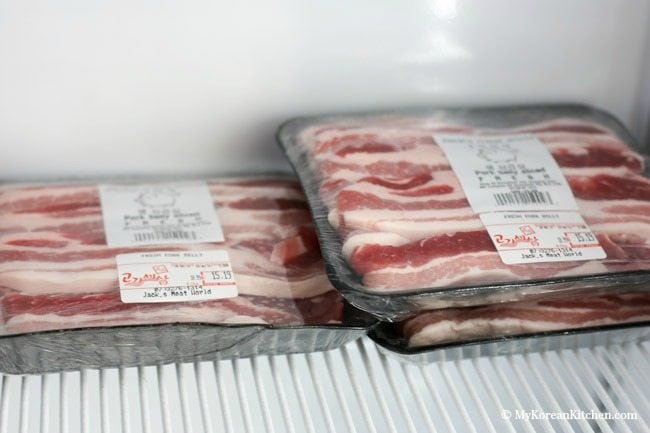
Korean pork belly (Samgyeopsal: 삼겹살) – Koreans love Samgyeopsal. Samgyeop means three layer so Samgyeopsal means three layered meat. This meat is typically used on a BBQ. It is popular in both the non-marinated and marinated way.
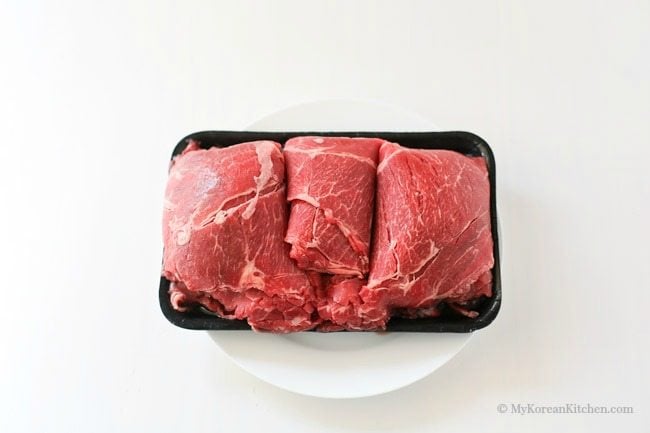
Sirloin (Deungshim:등심) or Tenderloin (Anshim: 안심) – Beef sirloin or tenderloin is commonly used when making Bulgogi (Korean marinated BBQ beef, 불고기), Miyeok guk (Korean seaweed soup, 미역국) and Japchae (Korean glass noodles, 잡채).
Love Korean food? Browse lots more Korean recipes from my easy Korean recipe collections. And subscribe to my newsletter for all of the latest updates including new recipes, what MKK communities are cooking and K-Dramas!

